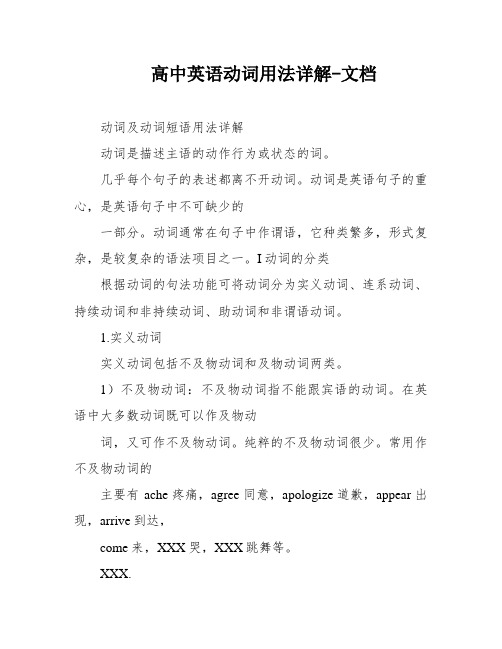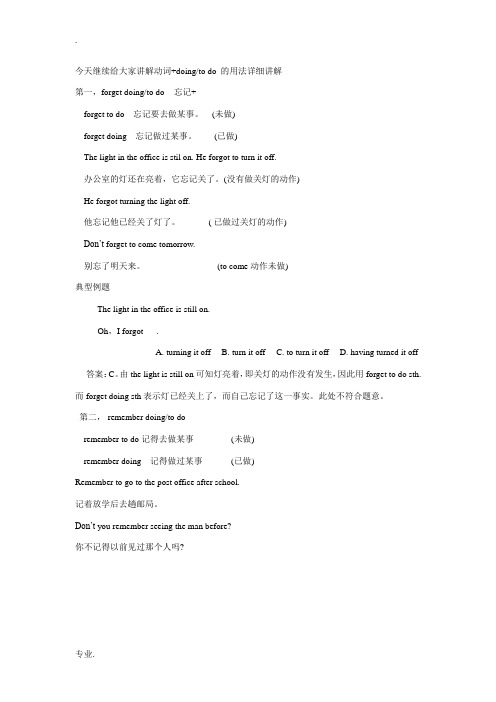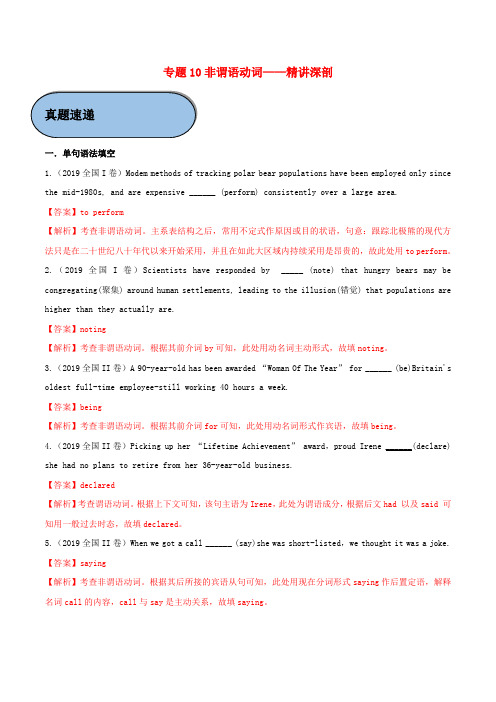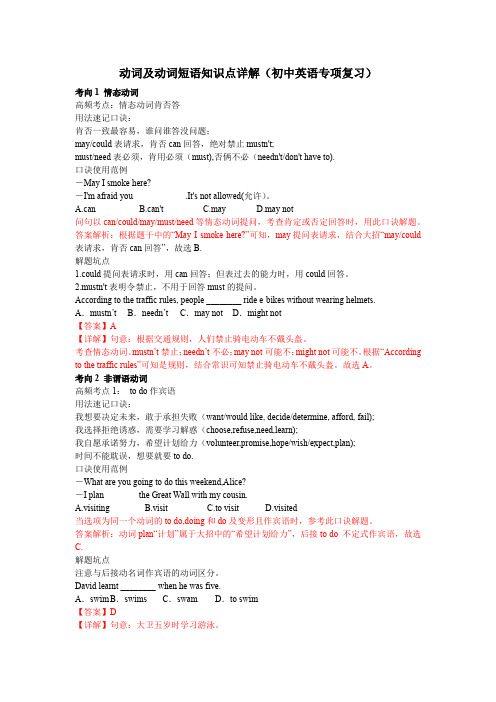动词以及动词短语的用法(动词后加to-do-还是doing)
高中英语动词用法详解-文档

高中英语动词用法详解-文档动词及动词短语用法详解动词是描述主语的动作行为或状态的词。
几乎每个句子的表述都离不开动词。
动词是英语句子的重心,是英语句子中不可缺少的一部分。
动词通常在句子中作谓语,它种类繁多,形式复杂,是较复杂的语法项目之一。
I动词的分类根据动词的句法功能可将动词分为实义动词、连系动词、持续动词和非持续动词、助动词和非谓语动词。
1.实义动词实义动词包括不及物动词和及物动词两类。
1)不及物动词:不及物动词指不能跟宾语的动词。
在英语中大多数动词既可以作及物动词,又可作不及物动词。
纯粹的不及物动词很少。
常用作不及物动词的主要有ache疼痛,agree同意,apologize道歉,appear出现,arrive到达,come来,XXX哭,XXX跳舞等。
XXX.我们一直等到妈妈来。
2)及物动词:能跟宾语的动词称为及物动词。
英语中的动词大多数为及物动词。
(1)跟单宾语的及物动词只跟一个宾语的动词称为单宾语动词。
常见的单宾语动词主要有:accept接受,admire羡慕,admit承认,affect影响,afford买得起,announce公布,borrow借出,XXX埋等。
I'm sorry that I XXX.对不起我忘了你的电话号码。
(2)跟双宾语的及物动词可以同时跟两个宾语的及物动词叫双宾语动词。
双宾语中的一个宾语指人,称为间接宾语,一个宾语指物,称为间接宾语。
间接宾语普通位于直接宾语之前,也可位于其后,但此时在间接宾语的前面需加介词to或for。
直、间接宾语易位需加to的动词介词to侧重指动作的方向,表示朝着、向着、对着某人。
常见的此类动词有:tell通知,XXX借等。
Hand me that book, please.= Hand that book to me, please.请把那本书递给我。
直、间接宾语易位需加for的动词介词for侧重指动作的受益者,透露表现为或人、替或人。
高考英语 语法讲座素材第11讲forget_doingto_do的用法(1) 新人教版

.今天继续给大家讲解动词+doing/to do 的用法详细讲解第一,forget doing/to do -忘记+forget to do忘记要去做某事。
(未做)forget doing忘记做过某事。
(已做)The light in the office is stil on. He forgot to turn it off.办公室的灯还在亮着,它忘记关了。
(没有做关灯的动作)He forgot turning the light off.他忘记他已经关了灯了。
( 已做过关灯的动作)Don’t forget to come tomorrow.别忘了明天来。
(to come动作未做)典型例题---- The light in the office is still on.---- Oh,I forgot___.A. turning it offB. turn it offC. to turn it offD. having turned it off答案:C。
由the light is still on 可知灯亮着,即关灯的动作没有发生,因此用forget to do sth. 而forget doing sth表示灯已经关上了,而自己忘记了这一事实。
此处不符合题意。
第二, remember doing/to doremember to do 记得去做某事 (未做)remember doing记得做过某事 (已做)Remember to go to the post office after school.记着放学后去趟邮局。
Don’t you remember seeing the man before?你不记得以前见过那个人吗?专业.。
最全动词的后面只能加doing或者 to do

为什么动词后有时加“to do”有时加“doing”?英语中有很多所谓的“动词短语”,比如下面这些常见的:plan to dodecide to do……want to do……use to do……be used to doing……(嗯,跟上面这个有啥区别呢?)look forward to doing……(写书信一定都会写这句吧?)devote oneself to doing……要点1:“to do”叫动词不定式动词不定式,可以理解为是一种固定结构,其中的"to"可以翻译成“去”,它用来衔接“to”前后的两个动词,表示动作先后发生,由第一个动作转移到第二动作上。
有些动词后可以接"to do",就是因为需要表达“把一个动作转移到另一个动作上”这种含义。
举例说明一下。
decide to buy sth (决定“去”买东西)plan to study(计划“去”学习)want to see movie(想要“去”看电影)要点2: “to doing”不是固定结构,to是介词“to doing” 不是什么固定结构,仅仅因为"to"做介词词性时,后面可以加doing (此时doing叫动名词,任何一个动词加ing都可以变成动名词,可以加在任意介词后使用,因为“介词+名词”)。
所以,to后面要加“doing"其实是因为to 和其它动词(或形容词、名词)搭配,构成了特定的短语,其中to做介词。
此时就不再把"to"翻译成“去”,而可以翻译成“对于、于……”,“和、与……”等语义。
look forward to……(对某事期待)devote oneself to……(投身于某事)make contribution to……(对某事做贡献)have access to……(和某事接触)be similar to……(和某事相似)be related to……(和某事相关)thanks to……(多亏某事)in additon to……(除了某事)以上动词短语、名词短语、形容词短语中的to”全部都是介词,这些短语后面都要加名词(注意,我特地翻译成“某事”,就是想强调后面加名词),所以一旦碰到动词,后面就只能接“doing ”,把动词变名词,才不会出现语法错误。
动名词的规则变化

动名词的规则变化动名词的规则变化1 一般情况下,直接在动词后加-ing (现在进行时)eg: work ---- working study ----- studying2 动词以不发音的-e结尾,要去-e加-ing take ----- taking make ----- making3 重读闭音节的动词,要双写词尾字母,再加-ing cut ----- cutting put begin4 以-ie结尾的动词,把变成y再加-ing lie ----- lying tie ----- tying die ----- dying英语语共有十六个时态、四个体。
(注:四个体为——一般、进行、完成、完成进行。
)英语中的四个体相当于法语、西班牙语以及所有印欧语系罗曼语族中的式,如:直陈式,命令式等。
(1)一般现在时基本形式(以do为例):主动态:do;被动态:doing、be done;过去时:did;第三人称单数:does(主语为非第三人称单数);肯定句:主语+动词原形+其他;否定句:主语+don‘t+动词原形+其他;一般疑问句:Do+主语+动词原形+其他。
肯定回答:Yes,+主语+do.否定回答:No,+主语+don't.特殊疑问句:疑问词+一般疑问句语序(2)一般过去时be动词+行为动词的过去式was/were+not;在行为动词前加didn‘t,同时还原行为动词was或were放于句首;用助动词do的过去式did提问,同时还原行为动词(3)一般将来时am/are/is+going to+dowill/shall+doam/is/are/about to + doam/is/are to + do一般将来时的表达方法be going to +动词原形be +不定式,be to+动词原形,be about to +动词原形be able to +不定式be about to+动词原形(4)过去将来时be(was,were)going to+动词原形be(was,were)about to+动词原形be(was,were)to+动词原形肯定句:主语+be(was,were)going to+动词原形~.否定句:主语+be(was,were)not going to+动词原形~.疑问句:Be(Was,Were)+主语+going to+动词原形~?肯定句:主语+would(should)+动词原形~.否定句:主语+would(should)not+动词原形~.疑问句:Would(Should)+主语+动词原形~?(5)现在进行时主语+be+动词ing〔现在分词〕形式第一人称+am+doing+sth第二人称+are+doing +sth第三人称+is+doing+sth(6)过去进行时肯定句:主语+was/were+doing+其它(11)现在完成进行时have/has been +-ing 分词(12)过去完成进行时had been +-ing 分词(13)将来完成进行时主语+ shall/will have been doing(14)过去将来进行时should(would)+be+现在分词(15)过去将来完成时should / would have done sth.(16)过去将来完成进行时should+have been+现在分词用于第一人称would have been+现在分词用于其他人称举例:英语中有12个主要时态,都来自于三时(过去、现在、将来)现在以I listen为例,举例英语中有12个主要时态如下所示:一般现在时:I listen现在进行时:I am listening过去进行时:I was listening现在完成时:I have listened现在完成进行时:I have been listening一般将来时:I shall listen”或“I will listen.”将来进行时:I shall be listening一般过去时:I listened过去完成时:I had listened过去完成进行时:I had been listening将来完成时:I shall have listened将来完成进行时:I shall have been listening英语中不存在属格一个普遍的误解是在英语中只存在一个以“'s”结尾表示所属的属格。
高考英语必考点专题10非谓语动词(精讲深剖)(含解析)

专题10非谓语动词——精讲深剖一.单句语法填空1.(2019全国I卷)Modem methods of tracking polar bear populations have been employed only since the mid-1980s, and are expensive ______ (perform) consistently over a large area.【答案】to perform【解析】考查非谓语动词。
主系表结构之后,常用不定式作原因或目的状语,句意:跟踪北极熊的现代方法只是在二十世纪八十年代以来开始采用,并且在如此大区域内持续采用是昂贵的,故此处用to perform。
2.(2019全国I卷)Scientists have responded by _____ (note) that hungry bears may be congregating(聚集) around human settlements, leading to the illusion(错觉) that populations are higher than they actually are.【答案】noting【解析】考查非谓语动词。
根据其前介词by可知,此处用动名词主动形式,故填noting。
3.(2019全国II卷)A 90-year-old has been awarded “Woman Of The Year” for ______ (be)Britain's oldest full-time employee-still working 40 hours a week.【答案】being【解析】考查非谓语动词。
根据其前介词for可知,此处用动名词形式作宾语,故填being。
4.(2019全国II卷)Picking up her “Lifetime Achievement” award,proud Irene ______(declare) she had no plans to retire from her 36-year-old business.【答案】declared【解析】考查谓语动词。
do the doing的短语用法

英语中的 do the doing 短语用法解析一、to do 和 to doing 的区别在英语中,to 后面可以接 do 或者 doing,但是它们的意义和用法是不同的。
to 后面接 do 时,to 是不定式标记,表示后面的动词是非限定性的,没有人称和时态的变化。
to 后面接 doing 时,to 是介词,表示后面的动词是名词化的,表示一种动作或状态。
我们可以通过以下的方法来判断 to 是不定式标记还是介词:如果 to 后面可以接一个名词(或名词短语),那么 to 就是介词,如果 to 后面不能接名词,那么 to 就是不定式标记。
如果 to 后面的动词可以用被动语态,那么 to 就是不定式标记,如果 to 后面的动词不能用被动语态,那么 to 就是介词。
例如:I want to watch a movie.(to 是不定式标记,后面不能接名词,可以用被动语态:A movie is wanted to bewatched by me.)I look forward to watching a movie.(to 是介词,后面可以接名词:I look forward to a movie.,不能用被动语态:*A movie is looked forward to being watched by me.)二、常见的 do the doing 的短语英语中有一些短语是由 do 和 doing 构成的,它们通常表示一种习惯、倾向、态度或目的。
这些短语的结构可以是:do + doing,如 do shopping, do reading, do cooking 等,表示做某种活动。
do + adj. + doing,如 do well/badly in doing sth., do good/harm in doing sth. 等,表示做某事的效果或影响。
do + prep. + doing,如 do without doing sth., do for doing sth., do by doing sth. 等,表示做某事的方式或条件。
语法第七章动词和动词短语

表示可能、请求允许时,could 不是can的过去式,而是表 示委婉语气表示可能性,常用于否定或疑问句中。 如:The man over there can’t be our teacher. Because he is much too fat. It could belong to Linda.
be friends be (in)
举一反三
中考 预 测
( B) 1. I’ll lend you the book, but you can only _____ it for 2
days.
A. borrow B. keep C. take D. return
(C ) 2. A big accident _____ the poor boy yesterday.
整,如love,buy,enjoy,teach,watch。 注:及物动词+宾语: I really enjoy the movie. 及物动词+宾语+宾语补足语:
I often hear her singing in the next room.
及物动词+间接宾语+直接宾语: Mother bought me a beautiful dress.
A. happened C. happened to B. happen to D. was happened to
考 点 3系 动 词、 助 动 词 1. 系动词系动词本身有意义,但不能单独作谓语,必须和表 语在一起构成谓语,说明主语的状态、性质、特征或身份。
分类 例词 备注
be 动词 变化类系动词 状态类系动词
isn’t,am not,aren’t, wasn’t,weren’t don’t,doesn’t, didn’t hasn’t,haven’t, hadn’t won’t,shan’t
2023年英语中考语法总复习—10.非谓语动词

十、非谓语动词构成:(to) + 动词原形动词不定式作用:作除谓语外的任何成分构成:v.-ed(规则动词)动词的非谓语形式过去分词作用:表、定、状、补构成:v.-ing动名词作用:主、宾、表、定一、动词不定式1. 不定式的构成动词不定式的基本形式:(to) + do, 其否定形式为:not + (to) do。
3. 不定式的特殊用法①常接"疑问词+带to的不定式"的动词有teach, show, tell, learn, find out, decide, know, forget等。
►My mother taught me how to cook yesterday. 昨天我妈妈教我如何做饭②使役动词和感官动词后跟动词不定式作宾语补足语,须省略to。
此类动词有:一感(feel)、二听(hear, listen to)、三让(let, make, have)、四看(look at, see, watch, notice)、五帮(help)。
变为被动语态时,省略的to 则要加上。
③常见的动词不定式句型:1)It takes sb. + some time + to do sth. 意为:做某事花费某人多长时间。
2)It’s + sb’s +名词+ to do sth. 意为:做某事是某人的……3)It’s +形容词+ (for/of sb) + to do sth. 意为:某人做某事是……注意:当形容词为kind, careless, clever, wise, foolish, honest, lazy, kind, silly, stupid等描述人的品质和特点的词时,应选择介词of,其他情况选择for。
④常见的一些不带to的动词不定式:Why not do …? Why don’t you do …? had better(not) do …, would rather do…, Could/Will/Would you please do …? 例如:I would rather stay in the room. 我宁愿呆在家里。
动词不定式和动名词的用法

非谓语动词不定式(infinitive)1.不定式的用法不定式的基本形式为“to do”, 在句中不单独作谓语;本身具有名词、形容词和副词的特征,在句中充当主语、宾语、表语、定语、状语和补足语。
(1) 作主语:例:To see is to believe. 眼见为实。
To grasp English in a short time is not easy.在短时间内掌握英语不容易。
注意:为保持句子平衡,可用“it”作形式主语,而将真正主语动词不定式放在后边,句型为:It is /was…to do sth.例:It is not easy to grasp English in a short time.在短时间内掌握英语是不容易的。
It was important for him to solve the problem then.当时对于他来说,解决这个问题是重要的。
(2) 作宾语:多在单宾语及物动词后用作宾语,有时也可用在某些复合宾语及物动词及个别双宾语及物动词后。
例:I want to have a walk after supper.晚饭后我想去散步。
He considered it his duty to support his family.他认为支撑他的家庭是他的责任。
She doesn’t know how to run the machine.她不知道如何操作这台机器。
不定式作宾语的结构为:及物动词+ to do. 动词常用:advise, agree, ask, begin, continue, decide, expect, forget, hope, learn, like, manage, mean, pretend, start, try, want, wish等。
(3) 作表语:联系动词一般都是be。
例:Our duty is to clean the office and the windows in it.我们的责任是打扫办公室以及把办公室里的窗户擦干净。
动词以及动词短语-高中英语语法记忆框架版(精编)

动词以及动词短语一. 定义表示动作或状态的词叫做动词。
动词决定着句子意思的表达,同时又决定着句子的语法结构。
1.根据动词在句中的功能,动词可分为四类,分别是:实义动词、系动词、助动词、情态动词。
很多动词是兼类词。
例如:We are having a meeting.我们正在开会。
(have是实义动词。
)He has gone to New York.他已去纽约。
(have是助动词。
)2. 根据动词后是否带有宾语,可分为及物动词与不及物动词两类(英语缩写形式分别为vt. 和vi.)。
同一动词有时可用作及物动词,有时可用作不及物动词。
例如:She can dance and sing.她能唱歌又能跳舞。
(sing在此用作不及物动词。
)She can sing many English songs.她能唱好多首英文歌曲。
(sing用作及物动词。
)实义动词又可分为延续性动词和非延续性动词3. 动词根据是否受主语的人称和数的限制,可分为谓语动词和非谓语动词两类。
如:She sings very well. 她唱得很好。
(sing受主语she的限制,故用第三人称单数形式sings。
)She wants to learn English well. 她想学好英语。
(to learn不受主语she的限制,没有词形变化,是非限定动词。
)英语中共有三种非谓语动词:动词不定式、动名词、分词。
4. 根据动词的组成形式,可分为三类,分别是:单字词、短语动词、动词短语例如:The English language contains many phrasal verbs and verbal phrases. 英语里有许多短语动词和动词短语。
(contains是单字动词。
)Students should learn to look up new words in dictionaries.学生们学会查字典。
(look up是短语动词。
初中英语常用动词搭配及动词短语以及辨析.doc

初中英语常用动词搭配1.动词后接 to doask sb. to do sth.请(叫)某人做某事tell sb to do sth告诉某人做某事order sb to do sth.命令某人做某事want sb to do sth.想要做某事help sb. (to) do sth.帮助某人做某事wish sb to do sth.希望某人做某事would like to do sth.想要做某事invite sb. to do sth.邀请某人做某事drive sb. to do sth .驱使某人做某事expect sb. to do sth.期待某人做某事forbid sb. to do sth.制止某人做某事force sb. to do sth.强迫某人做某事hope to do sth.希望做某事offer to do sth.主动提出做某事plan to do sth.计划做某事prepare to do sth.预备做某事pretend to do sth.假装做某事promise to do sth.许诺做某事decide to do sth.决定做某事refuse to do sth.拒绝做某事fail to do sth.未能做某事happen to do sth.碰巧做某事need sb to do sth需要某人做某事2.动词后接 ingconsider doing sth.考虑做某事enjoy doing sth.喜欢做某事escape doing sth.逃脱做某事feel like doing sth.想要做某事finish doing sth.完成做某事give up doing sth.放弃做某事imagine doing sth.想象做某事mind doing sth.介意做某事practice doing sth.练习做某事prevent doing sth.阻止做某事put off doing sth.推迟做某事risk doing sth.冒险做某事forbid doing sth.制止做某事forgive doing sth.原谅做某事stop doing阻止某人做某事appreciate doing sth.感激做某事suggest doing sth.建议做某事be/get used to doing sth.习惯做某事pay attention to doing注意做某事avoid doing避免做某事3.动词后既接 to 又接 ing(1) remember to do sth.记得要做某事remember doing sth.记得做过某事(2) forget to do sth.忘记要做某事forget doing sth.忘记做过某事(3) regret to do sth.遗憾要做某事regret doing sth.遗憾做过某事(4) try to do sth.尽力做某事try doing sth.试着做某事(5) stop to do sth.停下来去做某事stop doing sth.停止做(正在做的)某事(6) mean to do sth.打算做某事mean doing sth.意味着做某事(7 ) can ’t help to do sth.不能帮助做某事can’t help doing sth.情不自禁做某事(8) go on/continue to do sth.继续做另一件事go on/continue doing sth.继续做同一件事(9) like/love/hate to do sth具体活动(一次性)like/love/hate doing sth表示习惯(一贯性)(10) need/want to do sth.想要做某事(主动)need/want doing sth.想要被做(被动)(11) allow sb. to do sth.允许某人做某事allow doing sth允许做某事(12) advise sb. to do sth.建议某人做某事advise doing sth.建议做某事(13) encourage sb. to do sth.鼓励某人做某事encourage doing sth.(14) permit sb to do sth 某事permit doing sth鼓励做某事允许某人做允许做某事(1) let sb. do sth.(2) make sb. do sth.=make sth done(3) have sb. do sth.=have sth done让某人做某事使某人做某事使某人做某事4.动词后接动词原形 do(4) see sb. do sth. 看见某人做过某事see sb. doing 看见某人正在做某事(5) hear sb. do sth. 听见某人做过某事hear sb. doing 听见某人正在做某事(6) find sb. do sth. 发现某人做过某事find sb. doing sth. 发现某人正在做某事(7) watch sb. do sth. 察看某人做某事(8) had batter do sth. 最好做某事4.接双宾语( 一 ) 双宾语易位时需借助介词to 的常用动词(多表示动词的方向)bring sb. sth. = bring sth. to sb. 把某物带给某人hand sb. sth. =hand sth. to sb. 把某物递给某人lend sb. sth. = lend sth. to sb. 把某物借给某人mail sb. sth. = mail sth. to sb. 把某物寄给某人offer sb. sth. = offer sth. to sb. 将某物给某人pass sb. sth. = pass sth. to sb. 把某物递给某人pay sb. sth. = pay sth. to sb. 付给某人某物(钱)read sb. sth. = read sth. to sb. 把某物读给某人听return sb. sth. = return sth. to sb. 把某物还给某人sell sb. sth. = sell sth. to sb. 把某物卖给某人send sb. sth. = send sth. to sb. 把某物送给某人show sb. sth. = show sth. to sb. 拿某物给某人看take sb. sth. = take sth. to sb. 把某物拿给某人teach sb. sth. = teach sth. to sb. 教某人某物tell sb. sth. = tell sth. to sb. 告诉某人某情况throw sb. sth. = throw sth. to sb. 把某物扔给某人write sb. sth. = write sth. to sb. 给某人写信( 二 ) 双宾语易位时需借助介词for 的常用动词(多表示动词的目的)book sb. sth. = book sth. for sb. 为某人预定某物buy sb. sth. = buy sth. for sb. 为某人买某物choose sb. sth. = choose sth. for sb. 为某人选某物cook sb. sth. = cook sth. for sb. 为某人煮某物draw sb. sth. = draw sth. for sb. 为某人画某物find sb. sth. = find sth. for sb. 为某人找到某物get sb. sth. = get sth. for sb. 为某人拿来某物make sb. sth. = make sth. for sb. 为某人做某物order sb. sth. = order sth. for sb.为某人订购某物pick sb. sth. = pick sth. for sb.为某人采摘某物prepare sb. sth. = prepare sth. for sb.为某人准备某物save sb. sth. = save sth. for sb.为某人留某物sing sb. sth. = sing sth. for sb.为某人唱某物(歌)steal sb. sth. = steal sth. for sb.为某人偷某物初中英语常用动词短语整理5.Be 动词结构be able to do 能够做⋯⋯be afraid to do ( 内心 ) 害怕不敢做某事be afraid of doing 担心出现 doing 的状况、结果be angry with 对⋯⋯生气be at home = stay at home待在家里be back/in/out 回来 / 在家 / 外出be bad for 对⋯⋯有害be busy doing/with sth 忙于做⋯⋯ ( 忙于⋯⋯ )be careful of 当心,注意,仔细be covered with 被⋯⋯覆盖be different from 与⋯⋯不同be famous/known as 作为⋯⋯出名be famous/known for 以⋯⋯而著名be free 空闲的,有空be friendly/kind to 对⋯⋯友好be from = come from 来自⋯,什么地方人be full of/filled with 装满⋯⋯be good at= do well in 擅长于⋯be good for 对⋯⋯有好处be (ill) in bed 卧病在床be interested in 对⋯⋯感兴趣be in trouble 处于困境中be late for 迟到be mad at 对⋯⋯生气be made from/of 由⋯⋯制成be made in 在⋯⋯地方制造be made up of 由⋯⋯构成be on 在进行,在上演,(灯)亮着be pleased with 对⋯感到高兴be polite/impolite to 对某人有礼貌 / 不礼貌be popular with受⋯⋯欢迎;be proud of对⋯⋯感到自豪be ready for为⋯⋯作好准备be satisfied with对⋯⋯感到满意(高兴)be surprised (at)对⋯⋯感到惊讶be strict in sth.对某事严格be strict with sb.对某人严格be supposed to do sth.应该做某事be used for doing被用来做某事be used to do被用来做某事be used to doing习惯于be worried about =be anxious about担忧6.短语(首字母排列)aim at针对⋯agree with sb.同意某人的意见或建议ask for请求、索要ask for a day off请一天假add⋯ to ⋯把⋯和⋯加起来achieve a victory取得胜利arrive in到达﹙大地方﹚arrive at到达﹙小地方﹚argue with与⋯争吵apologize to向⋯道歉break up with sb. 与某人断绝关系break out 爆发break down 出毛病,拆开break off 解散,解雇break the rule 违规break into 破门而入believe in 信任begin/start with以⋯开始belong to属于⋯built ⋯ into ⋯把⋯建成⋯base on 以⋯为基础borrow ⋯ from ⋯向⋯借⋯⋯come into being 形成、出现come true 实现come for a visit 来参观come on 快,走吧,跟我来come back 回来come to do sth. 逐渐做某事come about 发生come from 来自⋯come up with 提出主意想法come along 出现、发生come over 过来come into 进入⋯里come in 进来come out 出来,出现,出版come out of 从⋯里出来catch up with 赶上⋯catch a fire 着火catch hold of 抓住⋯catch a bus 赶公共汽车cut up 切碎cut in half 切成半cut off 切断﹙电源、水源﹚cut in line 插队care for 关心、关爱care about 在意call for 号召call back 回电话call at sp. 拜访某地call on sb. 拜访某人call out 呼喊call up 给⋯打电话call sb. at some number 给某人打某个号码calm down 镇静下来communicate with 与⋯交流complain about 抱怨⋯can’ t wait to do sth. 迫不及待做某事clean up清理、打扫干净carry out执行connect⋯to⋯ 把⋯和⋯连起来chat on line网上聊天check over检查drop by 顺便拜访drop out of school 辍学drop litter 丢垃圾do an experiment 做实验do an operation on sb.给某人做手术do sth. in person 亲自做某事do business 做生意do exercise 做操do with=deal with 处理do wrong 做错事do one ’ s homework =do one ’lesson 做作业do some sports做运动do morning exercises做早操do well in做得好,擅长于do the dishes洗餐具do one ’ s best to do sth.尽力做某事do some cleaning扫除do some reading读书do some shopping购物do some cooking做饭do the laundry洗衣服do some chores做杂务disagree with sb. 不同意某人意见describe ⋯ as⋯把⋯描绘为⋯die of 死于﹙直接内因,如疾病、饥渴﹚die from 死于﹙间接外因,如车祸、天灾﹚die out 灭绝drive sb. crazy 使某人发疯drive to ⋯开车去⋯divide ⋯ into ⋯把⋯分成⋯depend on 依赖⋯decide on sth. 对⋯⋯做决定dry out 干涸dry up 烘干dream of梦想⋯draw up 起草、拟定dress up装扮、打扮e-mail sb.给某人发电子邮件enjoy oneself玩得愉快enjoy doing sth.喜欢做某事end up doing sth.结束做某事explain to sb sth=explain sth. to sb.向某人解释某事eat up吃光fall behind 落后fall off 从⋯⋯掉下fall down 滑到,倒下(后接宾语要加from )fall over 向前摔倒、跌倒fall into 落入;陷入fall ill 病倒fall asleep 入睡fall in love with 爱上、迷恋fight against 与⋯作斗争follow the rules 遵守规则fail the exam 考试不及格find out 查明﹙原因、真相﹚feel like doing 想做某事fly a kite 放风筝fly to 乘飞机去⋯fit into ⋯适应⋯fill in =fill out 填充填写fill ⋯ with ⋯用⋯填⋯feel sorry for 因⋯而难过fold the clothes 叠衣服get on上﹙车、船、飞机等﹚get off下﹙车、船、飞机等﹚get up起来、起床get good grades取得好成绩get over客服get rid of除掉⋯get to到达get out of从⋯里出来get into进入get in the way of 妨碍get together 聚会get into trouble 陷入困境get out of trouble 脱离困境get used to ﹙ doing ﹚sth. 习惯﹙做﹚某事get to do sth. 着手做某事get ready for 为⋯做准备get sb. into trouble 使某人陷入困境get away from 远离⋯get a sore back 背痛get back to sb. 过会儿与某人通话﹙打电话用语﹚get on/along well with 与相处⋯融洽get to know 认识get married to 与某人结婚get in touch with 与⋯取得联系go ahead 先走,向前走,去吧,干吧go to ⋯去⋯go home 回家go out 出去go out for ⋯出去做⋯go down/along 沿着⋯走go to school 上学go to the doctor ’去医务室go to the cinema 去看电影go across ⋯穿过⋯﹙平面﹚go to work 上班go bad 变坏go by 流逝﹙时间﹚go one ’ s own way 走自己的路go for a walk去散步go sightseeing去观光go away 走开go to sleep入睡go to bed上床睡觉go on with继续⋯go shopping去购物go hiking去远足go abroad出国go over复习go downstairs/upstairs下楼/上楼go on a trip去旅游give in ﹙ doing ﹚ sth. 屈服﹙做﹚某事 give up﹙ doing ﹚ sth. 放弃﹙做﹚某事give away赠送give out颁发give back归还give off发出﹙气味、烟雾等﹚give sb. some advice给某人提建议give a talk作报告give lessons to sb.给某人上课give sb. a good beating好好教训某人一下give sb. a hand帮某人忙grow up长大have a good time 玩得愉快have a discussion 进行讨论have a party 举行聚会have a meeting 开会have nothing to do with与⋯无关have trouble with sth. 做某事有困难have difficulty/ trouble doing sth. 费力做某事have fun 玩得愉快have a fever 发烧have a cold 感冒have a cough 咳嗽have a stamachache 胃痛have fun doing sth. 愉快地做某事have a match 举行比赛have a fight with 与⋯比赛、斗争have no idea of 不知道⋯have a hard time doing sth. 艰难地做某事have sth. to do with 与⋯有关have an accident 发生事故have breakfast/lunch/supper 吃早、午、晚饭have class 上课have water 喝水have a conversation with与⋯会话have a look at看一下⋯have a talk with与⋯谈话have a problem with做某事有疑难have a good trip路途愉快have a try 试一下have a laugh at 嘲笑 . ⋯have a pity on sb. 同情某人have a rest休息一下have a word with 与⋯⋯谈几句话hear of 听说hear from 收到⋯的来信hands up 举手hand in 上交hand out 分发hold up 抓住、握住hold a meeting 举行会议hold an exhibition 举行展览happen to do sth. 恰巧做某事hurry up 赶快hurry off 匆忙离开help oneself to sth. 随便用⋯help sb. with sth. 帮助某人做某事It ’s one ’s turn to do sth.轮到某人做某事invite sb. to do sth.邀请某人做某事insist on doing sth..坚持做某事join in穿着join together团结起来join the army参军join the party入党keep( stay )away from远离keep out 不让进入keep down 压低﹙音量等﹚keep a pet 饲养宠物keep in good mood 保持好心情keep on doing 一直做某事keep healthy 保持健康keep in good health 保持健康keep up with 跟上⋯keep sb. doing sth. 使某人一直做某事keep off 防御keep in touch with 与⋯保持联系knock at=knock on 敲⋯knock into撞到某人身上learn ⋯ by oneself自学⋯learn ⋯ from⋯向⋯学习learn ⋯ by heart记住⋯leave for离开去某处leave sth. somewhere把某物忘在某处leave school毕业leave one by oneself把某人单独留下leave a message for sb.给某人留个口信lead to 导致live on ⋯以⋯为生live a happy life 过着幸福的生活look after 照看⋯look for 寻找⋯look down on 藐视⋯look up 查找﹙字词等﹚look over 检查﹙身体等﹚look forward to 盼望⋯look on ⋯as 把看作⋯look at 看⋯look like 看起来像⋯look around 环顾look out 当心look out of 向⋯外面看look through 浏览look the same 看起来一样look inside 向⋯里面看laugh at 嘲笑lose touch with 与⋯失去联系let sb. in 让某人进去lie dowm 躺下make sb. feel at home使某人感到宾至如归make one ’s mind to do sth.决心做某事make a face=make faces 做鬼脸make money 挣钱make fool of sb.愚弄某人make a journey旅行make progress取得进步make a countribution to为⋯做贡献make a noise吵闹make a fire生火make a mistake犯错误make⋯ of ⋯由⋯制作⋯﹙看出原材料﹚make⋯ from ⋯由⋯制作⋯﹙看不出原材料﹚make up 编造,虚构,打扮,构成,组成make up of ⋯由⋯组成make a plan 定计划make one’ s bed 整理床铺make a report 编写报告make sure of 确信⋯make use of 利用⋯make a sentence with 用⋯造句make a decision 做出决定make oneself understood 表达自己的意思make a survey of 调查⋯make preparation for 为⋯做准备make friends with 与⋯⋯交朋友make a living 谋生major in 专修match ⋯ with ⋯把⋯和⋯搭配起来move to 搬到⋯mistake ⋯ for ⋯把⋯错认为⋯meet with遇到﹙困难、麻烦等﹚mix up 混合name sb./ 把某人 / 某物叫做Xorder sb. to do sth. 命令某人做某事 openup 完全打开play football踢足球play chess下棋play cards打牌play bridge打桥牌play the guitar弹吉他play the violin弹小提琴play sports做运动play games玩游戏play with玩耍⋯play jokes on sb.对某人开玩笑play the CD.播放play the music播放音乐play a part in在⋯中扮演角色play a role of扮演⋯的角色play against 与⋯比赛send⋯ for ⋯派⋯请⋯play hide-and-seek 捉迷藏send into 送入⋯里pay for 付⋯款send away 驱逐pay attention to 注意⋯send off 解雇pass by 路过⋯send out 发出,发出,派遣put on 穿上、上映shake hands with 与⋯握手put down 写下stick ⋯ into ⋯把⋯插入⋯里put away 把⋯收拾起来stick doing sth. 坚持做某事put ⋯ into ⋯把⋯放入⋯里stop sb. from doing sth. 阻止某人做某事put up 举起、张贴stare at 盯着⋯put out 熄灭sell out 买光put off 推迟see a doctor 看医生put back 放回see sb. off 为某人送行prevent sb. ﹙ from ﹚ doing sth. 阻止某人做see a film 看电影某事 prefer to do rather than do 与做另say goodbye to sb. 向某人告别一件事相比更喜欢做某事say hello to sb. 向某人问好prefer ﹙ doing ﹚ sth. to ﹙doing ﹚ sth. set up 竖立、建造与⋯相比更喜欢⋯set up one ’s mind on sth. 全神贯注于⋯point to 指向set off 出发,动身,使爆炸,引起poin at 指着set out 出发,启程,开始,着手point out 指出set an example for 为⋯⋯树立榜样practice doing sth. 练习做某事speak of 讲到pick up 拾起,接人,站起,收听speak highly of 称颂⋯search for 搜索,寻找run away 逃跑start to do sth. 着手做某事run after 追赶start with ⋯以⋯开始run out of 用光、从⋯里跑出来spend﹙ time/money ﹚on sth.= spendrun over to ⋯跑过去到⋯﹙ time/money ﹚﹙ in ﹚doing sth. 花费﹙时read sth. to sb. 把某物读给某人听间 / 金钱﹚做某事read sth. for sb. 替某人读某物spend time with sb. 和某人呆在一起receive a letter from ⋯收⋯到来信sort ⋯ into ⋯把⋯划分成⋯rain heavily 下大雨show sb. around somewhere 领某人参观某处ride a bike 骑自行车show up 露面rise up 升起stay in bed 呆在床上raise money 筹集资金slow down 减速refer to 涉及、提到smile at 对⋯微笑regard ⋯ as ⋯把⋯看作⋯suit sb. 适合某人reach out 伸出﹙手等﹚share ⋯ with ⋯与⋯分享⋯stay up 熬夜send up 发射stand for 代表,象征send an e-mail发送电子邮件stand up 起立send for ⋯派人请⋯succeed in doing sth.成功地做某事shut up关闭shout to (为了让人听到) 对⋯喊shout at (因生气等)向⋯喊seem like好像sweep the floor拖地step on践踏,踩take a message for sb. 给某人捎个信take a bus 乘工交车take one ’s order 按某人的顺序take a walk 散步take ⋯ to ⋯把⋯带到⋯去take a shower 淋浴take after 与⋯相像take away 带走take the medicine 服药take exercise 锻炼take it easy 不要紧take one ’s temperature 量某人的体温take off 起飞 / 脱下﹙衣服、鞋帽等﹚take a lesson/class 上课take a day off 休一天假take an exam 参加考试take ⋯ out of ⋯把⋯从⋯中取处来take a rest 休息一下take one ’s turn to do sth. 按某人顺序做某事 take part in 参加﹙活动﹚take ⋯ as an example 拿⋯当作例子take over 接管take care of 照顾、照看take in 吸取,吸收take up 占据﹙空间、时间﹚take the pride in以⋯而骄傲﹙强调动作﹚take place 发生﹙不及物﹚take the leading position 占主导地位take a swimming course 上游泳课take a deep breath 深呼吸take the place of 代替⋯take a photo of 照⋯的相talk about 谈论⋯talk with 与⋯谈话talk to对⋯谈话turn left ﹙right ﹚向左﹙右﹚转turn up 调高﹙音量等﹚turn down 调低﹙音量等﹚turn on 打开﹙电器、煤气、水龙头﹚turn off 关闭﹙电器、煤气、水龙头﹚turn over 翻开,翻转turn ⋯ into ⋯把⋯变成⋯turn to ⋯转向⋯turn green 变绿think about 考虑、思考⋯think of 想起、想到⋯think over 仔细考虑think up 想出(设计出、发明、编造)tell sb. about sth. 把某物的情况告诉某人tell a joke 讲笑话tell a story 讲故事try on 试穿try one ’ s best to do sth. . 尽力做某事thanks for 感谢⋯travel to ⋯到⋯旅行tie ⋯ to ⋯把⋯绑到⋯上treat ⋯ as ⋯把⋯当作⋯来对待trouble sb. to do sth.麻烦某人做某事throw away扔掉translate ⋯into ⋯把⋯翻译成⋯urge sb. to do sth.强烈要求某人做某事use up 用尽used to do sth.过去经常做某事visit sb/somewhere看望某人/参观某处wake up 醒来、叫醒welcome to ⋯欢迎到⋯来wait for 等待⋯wait in line 排队等候write to ⋯给⋯写信write down 记下win the World Cup赢得世界杯win a prize获奖wear out穿坏wear glasses戴眼镜wipe off擦去,拭去work out解决﹙问题、麻烦等﹚work on从事⋯walk along/down沿着⋯走watch a game观看比赛warn sb. to do sth.告诫某人做某事warn sb. of sth.警告某人某事warn sb. against(doing)sth. 告诫某人当心某事 / 不要做某事worry about⋯担心⋯中考英语近义动词(词组)辨析1. 辨析 take ;cost ; spend ; pay主语为人的有spend 和 pay;主语为物的有cost ( 1) spend 多用人作主语,后接金钱或时间。
动词用法小结(五篇范文)

动词用法小结(五篇范文)第一篇:动词用法小结动词用法小结一、如何变一般疑问句: 1. 有be动词(am,is,are),情态动词can, may, would的,直接将这些词提前,句尾加?。
2. 实意动词作谓语的,在句首加Do或Does,谓语动词用原形。
3. 在一般疑问句中,some变any(委婉请求的句子不变),and可变为or。
4. 一般疑问句用Yes或No回答。
二、如何变否定句:1. 有be动词(am,is,are),情态动词can, may, would 的,直接在这些词提后加not,可缩写。
2. 实意动词作谓语的,在谓语动词前加don’t或doesn’t,谓语动词用原形。
3. 在否定句中,some变any,and变为or。
三、固定搭配1. 使用动词原形(do)的几种情况:① 助动词(do,does)及情态动词(can,may,would)后跟动词原形;② 祈使句的句首用动词原形;③ help sb. do sth.(帮助某人做某事)let sb. do sth. (让我们做某事)。
2. 使用动词不定式(to do)的几种情况:① to do作目的状语,如:Come to visit② to do作定语,如:a funny time to eat breakfast; a good place to visit, sth. to eat/drink;③ want to do =would like to do(想做某事);want sb to do =would like sb to do(想让某人做某事);hope to do=wish to do(希望做某事);help sb. to do sth.(帮助某人做某事)like/love to do(喜欢做某事;某次具体的);ask/tell sb (not) to do(要求/告诉某人(不)做某事);learn to do (学习做某事);need to do(需要做某事);teach sb to do (教给某人做某事)2. 使用动词ing(doing)的几种情况:①介词后,如:with,at,in, on, about, for …② like/love doing(喜欢做某事;习惯性的);enjoy doing (喜欢做某事); have fun doing(做某事开心),be busy doing (忙于做某事);考试注意事项:1. 考前听十分钟听力,背Unit1-10所有黑体词,背Units6-10的grammar focus和3a。
动词及动词短语知识点详解(初中英语专项复习) (10)

动词及动词短语知识点详解(初中英语专项复习)考向1 情态动词高频考点:情态动词肯否答用法速记口诀:肯否一致最容易,谁问谁答没问题;may/could表请求,肯否can回答,绝对禁止mustn't;must/need表必须,肯用必须(must),否俩不必(needn't/don't have to).口诀使用范例-May I smoke here?-I'm afraid you .It's not allowed(允许)。
A.canB.can'tC.mayD.may not问句以can/could/may/must/need等情态动词提问,考查肯定或否定回答时,用此口诀解题。
答案解析:根据题干中的“May I smoke here?”可知,may提问表请求,结合大招“may/could 表请求,肯否can回答”,故选B.解题坑点1.could提问表请求时,用can回答;但表过去的能力时,用could回答。
2.mustn't表明令禁止,不用于回答must的提问。
According to the traffic rules, people ________ ride e-bikes without wearing helmets. A.mustn’t B.needn’t C.may not D.might not【答案】A【详解】句意:根据交通规则,人们禁止骑电动车不戴头盔。
考查情态动词。
mustn’t禁止;needn’t不必;may not可能不;might not可能不。
根据“According to the traffic rules”可知是规则,结合常识可知禁止骑电动车不戴头盔。
故选A。
考向2 非谓语动词高频考点1:to do作宾语用法速记口诀:我想要决定未来,敢于承担失败(want/would like, decide/determine, afford, fail);我选择拒绝诱惑,需要学习解惑(choose,refuse,need,learn);我自愿承诺努力,希望计划给力(volunteer,promise,hope/wish/expect,plan);时间不能耽误,想要就要to do.口诀使用范例-What are you going to do this weekend,Alice?-I plan the Great Wall with my cousin.A.visitingB.visitC.to visitD.visited当选项为同一个动词的to do,doing和do及变形且作宾语时,参考此口诀解题。
动词和动词短语、动词时态和语态、主谓一致 单句语法填空+单句改错——语法考点(动词篇)

7、后接-ing分词,主动形式表示被动意义的动词:need, require, deserve。 8、不能后接sb. to do的动词:afford, agree, arrange, choose, decide, hope, suggest, expect, offer, plan, promise, determine, demand, manage, fail, prepare, refuse, pretend, seem, set out(开始着手做某事)。 9、后接sb. of sth.的动词:remind, convince, rob, warn, inform, cure, suspect, accuse。 10、后接副词作表语,表示状态或特征;或强调状态时不用被动的动词: say, write, read, write, sell, wash, clean, wear, open, start, shut。 11、表示“计划、打算”的动词的过去完成时态可以表示“过去没有实现 的愿望或打算”:plan, mean。
to write
______ (write)
to his parents.
to think
23. Hearing the news,he started ______ (think) of a good way to solve
the problem.
to rain
24. We were about to leave when it began ______ (rain).
1、一般现在时 (1)现在一段时间里的经常性、习惯性、一般性的动作,常与 表示频率或频度的副词以及表示现在的时间状语连用。句子常常翻 译为:“常常做某事”。
英语中动词的用法总结

(一)动词概述动词是表示人或事物的动作、存在、变化的词。
根据其词义和其在谓语中的作用可分为实义动词、助动词和情态动词。
根据其在句子中的功用可分为及物动词,不及物动词和连系动词。
1)实义动词:意义完全,能独立用作谓语。
如:enable,watch,run,open等。
2)连系动词:是一个表示谓语关系的动词。
它必须在后面接表语(通常为名词或形容词)。
如:seem,look,smell,taste,sound,get,become,turn,be等。
3)助动词:本身没有词汇意义。
不能单独用作谓语。
在句中与实义动词一起构成各种时态、语态、语气以及否定和疑问结构。
如:do,does,did等。
4)情态动词:词义不完全。
在句中不能单独作谓语,只能与实义动词一起构成谓语。
如:can,may,must,need,ought to等。
(二)动词的时态1.动词的时态一共有16种,以ask为例,将其各种时态的构成形式列表如下:现在时过去时将来时过去将来时一般ask / asks asked shall/will ask should/would ask进行am/is/are asking was/were asking shall/will be asking should/would be asking 完成have/has asked had asked shall/will have asked should/would have asked完成进行have/has beenaskinghad been askingshall/will have beenaskingshould/would have beenasking1)一般现在时:概念:经常、反复发生的动作或行为及现在的某种状况。
时间状语:always, usually, often, sometimes, every week (day, year, month…), once a week, on Sundays, etc.基本结构:①be动词;②行为动词否定形式:①am/is/are+not;②此时态的谓语动词若为行为动词,则在其前加don't,如主语为第三人称单数,则用doesn't,同时还原行为动词。
(全)高考英语语法知识讲解-动词

高考英语语法知识讲解-动词动词在语法填空中的考查在语法填空中,动词的考查主要考虑时态、语态、非谓语动词、语气、主谓一致等。
近三年全国卷最常考的谓语动词是一般过去时或者主语是第三人称单数的一般现在时,并会涉及主谓一致与虚拟语气的考查,情态动词还未考过;被动语态常会涉及一般现在时或一般过去时的被动语态;而非谓语动词主要考查其基本形式:to do(to+原形动词,即动词不定式),doing(-ing形式,即现在分词或动名词),done(-ed形式,即过去分词)。
【应对策略】1.句中若缺少谓语,注意要考虑所给动词的时态和语态。
(1)判断时态首先要确定时间,然后根据动作发生的状态来判断应该运用哪种时态。
有时也可以根据空格后和该句中已经存在的谓语动词的并列关系来确定时态。
(2)句中缺少谓语,且与主语存在被动关系,考虑根据时间和动作存在的方式,确定相应时态的被动语态。
注意:只有及物动词才有被动语态。
2.如果句中已有谓语动词,并确定所给动词要填写为非谓语动词,就要考虑是v.-ing形式、过去分词形式还是动词不定式。
分析非谓语动词在句中作何成分,再根据各非谓语动词的特点确定填哪种形式。
(1)对于不定式的考查,需注意不定式的时态和语态,熟记常考的后跟不定式作宾语的动词以及一些常考句式。
(2)现在分词作状语,表示方式、伴随成自然而然的结果,且其主动形式与句子主语构成逻辑上的主动关系。
另外,现在分词的一般式状语,往往表示动作与谓语动词同时或相继发生;现在分词的完成式作时间状语,往往表示动作先于谓语动词发生。
现在分词作定语表示动作的主动或正在进行;动名词作主语表示一般的、抽象的或习惯性动作;此外,应熟记能用动名词作宾语的动词或动词短语。
(3)过去分词可作状语、定语或补足语,表示被动与完成;若作表语常考形容词化的过去分词;过去分词不可作主语或宾语。
(4)独立主格结构的非谓语动词要考虑与其逻辑主语的关系,with复合结构的非谓语动词要考虑与复合宾语的逻辑关系。
(完整版)英语动词不定式大全

英语动词不定式大全 动词不定式是一种活跃的非谓语动词。
它在句中起的是名词。
形容词或副词的作 用, 可在句子中作主语。
宾语。
定语。
状语和宾语补足语。
动词不定式的形式是 "to + 动词原形 ", 但 to 有时要省去。
动词不定式在具体运用时 , 用不用 to, 取决 于谓语动词的用法 :一。
带 to 的不定式结构1. 我们学过的能直接跟带 to 的不定式结构的动词主要有 :want, ask, tell, hope, learn, try, decide, forget, remember, like ,love, stop, go, come 等。
2. 动词不定式的否定形式是在不定式前直接加 not, 即 not to do sth. 。
例 如: Jim told me not to wake up Kate. 吉姆告诉我别叫醒凯特。
二。
不带 to 的不定式结构以下几种情况使用不带 to 的动词不定式 :1. 在固定词组had better 之后。
注意:had better 的否定形式是had better not do sth. 。
例如 :You had better go home now. 你最好现在回家。
It's cold outside. You'd better not go out. 外面很冷 , 你最好不要出去。
2. 在 let,make,see, feel, watch,hear 等感官或使役动词后 , 要跟不带 to 的动词不定式作宾语补足语。
例如 :I made them give me the money back. 我迫使他们把钱还给我。
I didn't see you come in. 我没看见你进来。
3. 在引导疑问句的 why not 之后。
"Why not+不带to 的不定式"是 Why don't you do …的省略,可以用来提出 建议或劝告。
- 1、下载文档前请自行甄别文档内容的完整性,平台不提供额外的编辑、内容补充、找答案等附加服务。
- 2、"仅部分预览"的文档,不可在线预览部分如存在完整性等问题,可反馈申请退款(可完整预览的文档不适用该条件!)。
- 3、如文档侵犯您的权益,请联系客服反馈,我们会尽快为您处理(人工客服工作时间:9:00-18:30)。
一动词加-ing 的情况
consider, suggest/advise,look forward to, excuse/pardon
admit,delay/put off,fancy
avoid,miss,keep/keep on,practise
deny,finish,enjoy/appreciate
forbid,imagine,risk
can't help,mind,allow/permit,escape
考虑建议盼原谅,
承认推迟没得想.
避免错过继续练,
否认完成就欣赏.
禁止想象才冒险,
不禁介意准逃亡.
如:建议:advise,suggest,冒险:risk,献身:devote oneself to
二动词后加doing 和加to do sth. 意思不一样的情况
①remember doing指记住过去做过的事,remember to do指记住将来要做的事,表示“不要忘记”。
②forget doing表示忘记过去做过的事,forget to do表示“没有想起做某事”。
③mean doing表示“意味着做某事”,mean to do表示“打算做某事”。
④regret doing表示对已做过的事感到后悔,regret to do表示对将要做的事表示遗憾。
⑤stop doing表示“停止做某事”,stop to do是停止做正在做的事以便去做另外一件事,这里的to do不是stop的宾语而是stop的目的状语。
⑥try doing表示“尝试做某事”,try to do表示“设法、试图做某事”。
⑦go on doing表示继续做同一件事,go on to do表示做完一件事后,接下去做另外一件事。
三动词后加to do sth.
afford负担得起agree同意appear似乎,显得arrange安排
ask问attempt企图beg请求begin开始
choose选择claim要求decide决定demand要求
desire愿望determine决定expect期望fail不能
forget忘记happen碰巧hate憎恨,厌恶hesitate犹豫
hope希望intend想要learn学习long渴望
love爱manage设法mean意欲,打算need需要
neglect忽视offer提供omit忽略,漏other扰乱;烦恼
plan计划prefer喜欢,宁愿prepare准备pretend假装
promise承诺,允许refuse拒绝regret抱歉,遗憾seek找,寻觅
start开始try试图volunteer志愿want想要
wish希望
四动词后加sb to do sth. (即:v.+sb/sth+to do): advise劝告allow允许ask要求,邀请beg请求
cause引起command命令direct指导drive驱赶
enable使能够encourage鼓励entitle有资格forbid禁止
force强迫get请,得到hate憎恶help帮助
inspire鼓舞instruct指示intend想要,企图invite吸引,邀请
lead引起,使得leave使,让like喜欢mean意欲,打算
need需要oblige不得不order命令permit允许
prefer喜欢,宁愿prompt促使pronounce断定recommend劝告,推荐remind提醒request请求require要求teach教
tell告诉tempt劝诱train训练urge激励,力说
want想要warn告诫wish希望
五
Allow sb to do \allow doing
Advise sb to do \advise doing
六to 为介词的用法to 后加doing sth.
be / get / become used to 习惯于
be given to 喜欢;癖好
be related to 与…有关系
be addicted to 沉溺于;对…上瘾
be opposed to 反对
devote oneself to献身于;专心于
be devoted to 致力于;忠诚于
be admitted to 被…录取;准进入
be reduced to 沦为
reduce…to…使…沦为
be attached to附属于;喜欢;依恋
be adjusted to 适应
be known to 为…所知
be married to 和…结婚
be sentenced to被判处
be connected to 和…连在一起
be exposed to 暴露于;遭受
be compared to 被比喻成
compare… to…把…比作…
be engaged to 与…订婚
be / become / get accustomed to // accustomed to 惯于;有…习惯
be engaged to 与…订婚
get down to 着手做
lead to 导致
object to反对;不喜欢;不赞成put one’s mind to全神贯注于give rise to 引起
look forward to 盼望
stick to 坚持
pay attention to 注意
attend to 专心;注意;照料
see to 负责;注意
contribute to对…作贡献;有助于make contributions to对…作贡献apply oneself to 致力于
come close to几乎;将近
reply to 回答
add to 增加。
